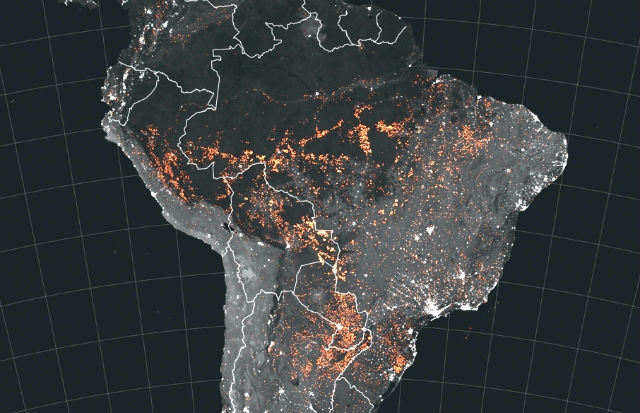


Researchers are trying to trace the destination of the particles emitted by the burning of biomass and measure the effects of deforestation on the mercury cycle of the Amazon rainforest. Satellite fire outbreaks between August 15 and 22, 2019. (image: Nasa)
Published on 05/04/2021
Maria Fernanda Ziegler, from Lyon | Agência FAPESP – Besides the loss of biodiversity and the impact on global climate, the deforestation caused by burning in the Amazon every year sends tons of mercury up into the atmosphere – a highly toxic element.
This has been studied by researchers from the Institute of Chemistry of the State University of Campinas (IQ-Unicamp) in the last 20 years, in collaboration with Brazilian and foreign institutions.
“Burning causes the mercury that would have been fixed to the Earth’s surface by the forest to go back up into the atmosphere. As it’s very volatile, this element can be transported on a local, regional, or global scale. It can drift for up to a year before being deposited in any part of the planet. For that reason mercury is considered to be a global pollutant,” said Anne Hélène Fostier, a professor at IQ-Unicamp, in a lecture given at FAPESP Week France.
The group led by Fostier is studying the biogeochemical cycle of mercury to try to discover the destination of the particles emitted by burning. For this, the researchers are using Multicollector-Inductively Coupled Plasma Mass Spectrometer (MC-ICPMS) techniques
The project, being carried out in collaboration with the French group led by Professor David Amouroux, of the Université de Pau et des Pays de l’Adour, is supported by FAPESP.
“We’re trying to find the isotopic signature of the mercury. This is a new research area, which has grown quickly over the last decade thanks to the modern mass spectrometry methods and other highly sensitive equipment,” said Fostier.
According to the research, mercury emissions into the atmosphere have grown considerably in the last 200 years. It is estimated that the atmospheric concentration is between 300% and 500% greater than in the pre-industrial era, due, above all, to the burning of fossil fuels, mining, and deforestation.
“As it’s a highly toxic substance, various governments have signed the Minamata Convention, which is meant to limit the use of this element and emissions,” she said.
According to the researcher, on a global scale, 8 thousand tons of mercury are emitted into the atmosphere every year, of which 2.5 thousand tons are anthropic in origin, 500 tons are of natural origin, and the rest correspond to reemissions (cases in which the mercury had been fixed to the surface, but returns up into the atmosphere).
“The Amazon rainforest is very efficient in removing atmospheric mercury, being responsible for 23% of all mercury deposition in the world. However, we’ve verified that forest fires may be responsible for reemitting a large part of that mercury,” she said.
That was what a study by the researchers from Unicamp, the National Institute for Space Research (Inpe), and the Paulista State University (Unesp) found. Based on the measurements carried out in controlled burning experiments in areas varying between 4 and 40 thousand square meters, it was possible to estimate that the Amazon rainforest is responsible for the direct reemission of 4 to 8 tons of mercury per year.
In this same study, measurements and projections were made regarding the burning of biomass and the emission of greenhouse gases and particulate matter, under the coordination of João Andrade de Carvalho Jr, a researcher at Unesp in Guaratinguetá.
In another study, developed in collaboration with the researcher from the City University of New York (United States) Antony Carpi, the group showed that while soils covered by preserved forest do not emit mercury into the atmosphere, these emissions annually represent 50% more than those resulting from the burning of biomass.
“The study shows that, when there’s vegetation, emissions are low. But when there’s deforestation, the ratio increases,” she said.
Fostier also highlighted the importance of analyzing the impact of climate change on the mercury cycle in the Amazon rainforest. Data from NASA, the American space agency, indicate that human activities are reducing the humidity of this ecosystem, leaving it more vulnerable to fire and extreme drought. The scenario, therefore, favors an increase in mercury reemissions in the next few years.
The FAPESP Week France symposium was held between November 21st and 27th, thanks to a partnership between FAPESP and the universities of Lyon and Paris, both in France. Read other news about the event at www.fapesp.br/week2019/france.
Source: https://agencia.fapesp.br/32159